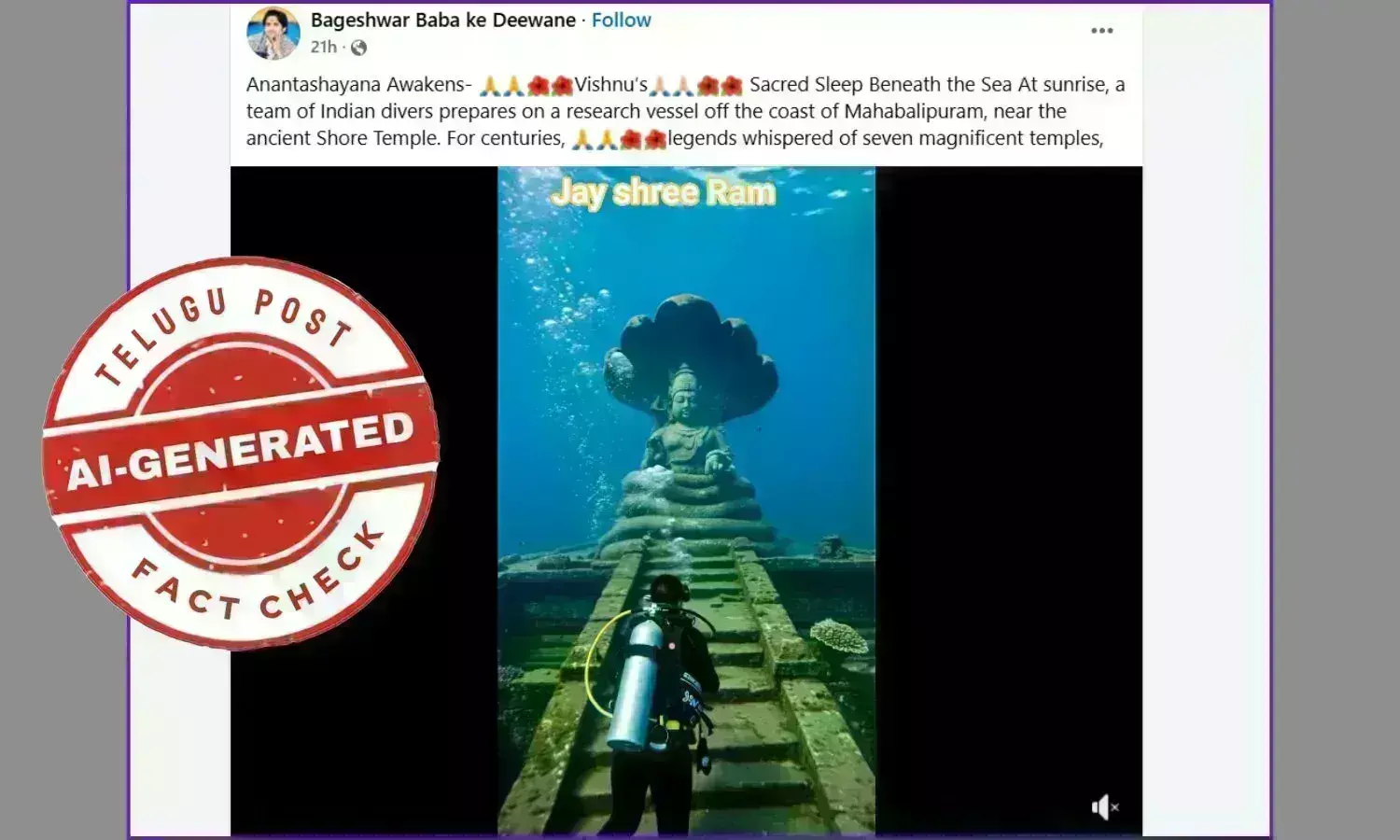Fact Check: Submerged Vishnu Temple visuals claiming from Mahabalipuram are AI generated
AI-generated video of Vishnu temple

Claim :
Viral video shows the submerged Vishnu Temple in Mahabalipuram, Tamil NaduFact :
The video is an AI generated representation of the temple, does not show the real visuals
Mahabalipuram, a coastal town in TN and UNESCO World Heritage site, is famed for its intriguing submerged ruins, believed to be part of the legendary Seven Pagodas. While only the Shore Temple remains visible above water, underwater explorations have revealed submerged temples and structures, including walls and carvings, attributed to geological and environmental factors like sea-level changes and coastal erosion. These ruins of significant cultural and historical importance, stand as testaments to the Pallava dynasty's architecture, draw considerable tourist interest and contribute to Mahabalipuram's mystical aura, inspiring folklore and ongoing research. In 2017, an underwater archaeological investigation in the in the north, south and 800m east of the shore temple revealed submerged man-made structures at a depth of 4-9 meters.
A video showing scuba divers swimming around submerged sculptures and other idols of Lord Vishnu, and also temple-like structures is in circulation with the claim that a team of Indian divers prepare a research vessel off the coast of Mahabalipuram, near the Shore Temple. They discovered the idol of Lord Vishnu in the Anantshayana pose resting on the coiled body of Sheshnag.
The video has been shared by several users with the captions like “Indian divers on exploration off coast of ancient #Mahabalipuram For centuries 7 magnificent temples been told of, 6 swallowed by sea. भारतीय गोताखोरों की एक टीम प्राचीन #महाबलीपुरम के एक शोध पर। सदियों से, सात भव्य मंदिरों के बारे में बताया है,छह समुद्र निगल गया। #तमिलनाडु”
Here are some Facebook post links.
Here is the archive link of the claim.
Fact Check:
The claim is False. The video in circulation has been generated using AI technology.
We partnered with the Deepfakes Analysis Unit to analyse the video and check whether the video is AI generated. We selected some of the distinctive visuals as screenshots and checked them using different AI detection tools.
We observed that the video seems to be better quality than the rest; in that the generative elements are very hard to detect with naked eye. With videos like this, we have noticed that some image classifiers detect evidence of generative elements in close-ups of monumental architecture. We uploaded the entire video to Hive AI's image classifier and took multiple keyframes to run it through multiple image classifiers.
Pika has been marked by the tool as a possible platform behind the generation of the visuals here. The tool, in general, has found it difficult to detect evidence of generative elements with high confidence. Here are the screenshots of the results.
We also ran keyframes through WasitAI detection tool and able to confirm that the video was generated using AI technology. Here are the screenshots of the results.
Upon further research, we found that the video was first shared by a user named jayprints on the Instagram account with the caption “Anantashayana Awakens: Vishnu’s Sacred Sleep Beneath the Sea. At sunrise, a team of Indian divers prepares on a research vessel off the coast of Mahabalipuram, near the ancient Shore Temple. For centuries, legends whispered of seven magnificent temples, six of which were swallowed by the sea. Their mission? To investigate sonar scans revealing something… massive. As they descend, the sea parts like memory — and there he lies. A colossal Lord Vishnu in the Anantashayana pose, resting upon the coiled body of Sheshnag, seven divine hoods arched in silence above him. A lotus blooms from his navel. Lakshmi sits at his feet. Coral clings to his form. Myth becomes monument. Divers reach out in reverence — their gloved hands touching a foot once worshipped in temple hymns. A world lost to water, now rediscovered. Inspired by the sunken temple myths of Mahabalipuram, Tamil Nadu. Crafted with love by @jayprints
Note: These visuals are AI-generated for artistic and cultural storytelling purposes. We honor all traditions with deep respect. #vishnu #lordkrishna #
#vishnubhagwan #isckon #
#trending #explorepage #
#hareramaharekrishna
When we checked the bio of this Instagram user, we found that he is an AI artist and shares a lot of AI generated videos and images on the account. Here is the screenshot of the bio.
When we searched for the images relating to the submerged ruins of the Vishnu temple in Mahabalipuram, we found a research paper named ‘Use of geospatial techniques in maritime archaeology with reference to the Tamil Nadu coast’ published on ResearchGate. The website also shared a few images of the submerged ruins of the temple of Mahabalipuram.
We can also see some more images shared in this article. These images are not as clear as the visuals in the viral video.
Therefore, the viral video is an AI-generated one, the visuals do not show the real visuals of the submerged temple in Mahabalipuram, Tamil Nadu. The claim is False.

